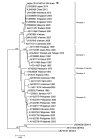Autochthonous dengue fever, Tokyo, Japan, 2014
- PMID: 25695200
- PMCID: PMC4344289
- DOI: 10.3201/eid2103/141662
Autochthonous dengue fever, Tokyo, Japan, 2014
Abstract
After 70 years with no confirmed autochthonous cases of dengue fever in Japan, 19 cases were reported during August-September 2014. Dengue virus serotype 1 was detected in 18 patients. Phylogenetic analysis of the envelope protein genome sequence from 3 patients revealed 100% identity with the strain from the first patient (2014) in Japan.
Figures


References
-
- Hotta S. Dengue vector mosquitoes in Japan: the role of Aedes albopictus and Aedes aegypti in the 1942–1944 dengue epidemics of Japanese Main Islands. Medical Entomology and Zoology. 1998;49:267–74.
-
- Ministry of Health. Labour and Welfare of Japan. Dengue fever [cited 2014 Oct 31]. http://www.mhlw.go.jp/bunya/kenkou/kekkaku-kansenshou19/dl/20141031-01.pdf
-
- World Health Organization. Dengue haemorrhagic fever: diagnosis, treatment, prevention and control. 2nd ed. Geneva: The Organization; 1997.
-
- Guzmán MG, Kourí G, Martínez E, Bravo J, Riverón R, Soler M, et al. Clinical and serologic study of Cuban children with dengue hemorrhagic fever/dengue shock syndrome (DHF/DSS). Bull Pan Am Health Organ. 1987;21:270 . - PubMed
Publication types
MeSH terms
LinkOut - more resources
Full Text Sources
Other Literature Sources
Medical

